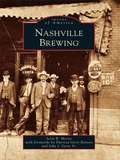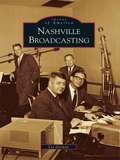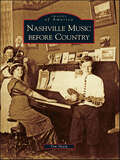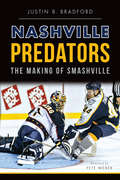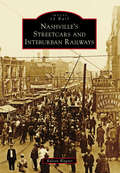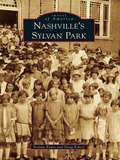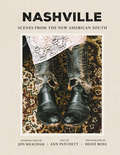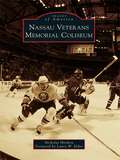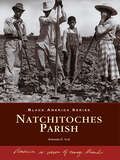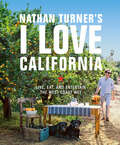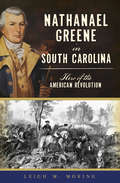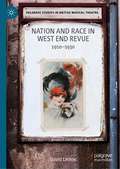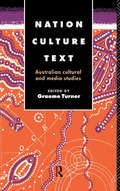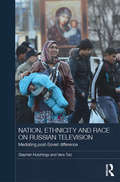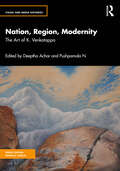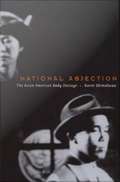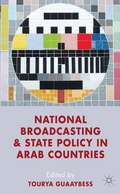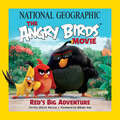- Table View
- List View
Nashville Brewing (Images of America)
by Scott R. Mertie Patricia Gerst Benson John J. Gerst Sr.Known for country music, antebellum homes, the Parthenon, and Civil War battlefields, Nashville also has a rich brewing history that spans 100 years. Several breweries were established in the late 1800s, but the William Gerst Brewing Company alone endured into the 20th century and even survived Prohibition. Once one of the largest breweries in the South, Gerst brewed its last batch in 1954, leaving Nashvillians unable to enjoy locally brewed beer until the dawn of the recent microbrewery revolution. Nashville Brewing offers readers a pictorial account of the William Gerst Brewing Company-an important but almost forgotten part of Nashville history.
Nashville Broadcasting
by Lee U. DormanBuilt by a 16-year-old high school student named Jack DeWitt, the first radio station in Nashville went on the air in 1922. Three years later, DeWitt helped start WSM, arguably one of the nation's greatest radio stations, and in 1950, he and WSM put Nashville's first television station on the air. Over the years, Nashville has had its share of local radio personalities, such as Noel Ball, Coyote McCloud, and Gerry House, as well as television personalities like Jud Collins, Bill Jay, and Larry Munson. Nationally recognized stars such as Dinah Shore, Oprah Winfrey, Pat Sajak, and Pat Boone started their careers in Nashville as well. Here are the stories and images of the people heard on transistor radios and the programs--including Five O'Clock Hop, Ruffin' Reddy, and The Mickey Mouse Club--watched by children while they did their homework.
Nashville Music before Country (Images of America)
by Tim SharpNashville is a name synonymous with music. Years before the first radio broadcast of country music from Nashville�s Grand Ole Opry, music and publishing were central to Nashville�s self-identity. Thousands of songs flooded into the Cumberland and Tennessee River valleys from Southern Appalachia, sung by folk performers. These songs became the foundation for the folk-hymn traditions that grew throughout Tennessee. Into this stream flowed a body of African American spirituals, gospel, and minstrel songs. The arrival of trained German musicians brought classical styles to this gathering stream of musical confluences. These musicians found a home in the academies and businesses of Nashville. Nashville Music before Country is the story of how music merged with education, publication, entertainment, and distribution to set the stage for a unique musical metropolis. The images for Nashville Music before Country come from private collections as well as public libraries and archives.
Nashville Predators: The Making of Smashville (Sports)
by Pete Weber Justin B. BradfordNashville may be the country music capital, but local hockey fans know it as Smashville. The Predators adopted their name from the bones of a saber-toothed tiger found beneath a local building. Craig Leipold first purchased the expansion rights in 1997, and the team quickly built a loyal following. It won twenty-eight games in the inaugural season. Twelve seasons later, the team finished second in the Central Division and appeared in its first-ever conference semifinals. One year later, it finally dispatched its long-standing rival Detroit Red Wings 4-1 in the opening round of the playoffs. Author Justin Bradford details the fascinating history through unique player anecdotes and perspectives from those involved in the team's rise to prominence.
Nashville's Jewish Community (Images of America)
by Lee DormanNashville's Jewish community traces its beginning to 1795 with the birth of Sarah Myers, the first Jewish child born here. Her parents, Benjamin and Hannah Hays Myers, were both from prominent pre-Revolutionary War families in New England and stayed in Nashville just one year before moving to Virginia. The next few settlers--Simon Pollock, a doctor, in 1843; the Frankland family in 1845; Andrew Smolniker and Dr. H. Fischel, a dentist, in 1848; and E. J. Lyons in 1849--stayed only a few years before moving on to Memphis, New Orleans, or elsewhere. The first to stay and achieve prominence was Isaac Gershon (later changed to Garritsen), who in 1849 opened his home on South Summer Street for High Holy Day services and in 1851 formed the Hebrew Benevolent Burial Association, purchasing land that still serves as Nashville's Jewish cemetery. The first Jewish congregation, Mogen David, followed in 1854. The Jewish population of Nashville, which began with five families and eight young men in 1852, today numbers about 7,500.
Nashville's Streetcars and Interurban Railways (Images of Rail)
by Ralcon WagnerNashville’s 150-year public transportation heritage is a rich and colorful one that began in 1866 when two private companies, the McGavock and Mount Vernon Horse Railroad Company and the South Nashville Street Railroad Company, commenced operation. The first cars were mule powered. During the 1880s, as streetcar routes became longer and too strenuous for animal power, steam dummy lines were introduced. On April 30, 1889, Nashville became one of the earliest cities served by electric street railways, developing a 70-mile system by 1915. In addition to its advanced streetcar system, Nashville was also served by two interurban railway systems. Over time, improved roads and affordable cars caused ridership on public transportation to drop rapidly. By February 1941, buses had replaced the last of the city’s aging streetcars. The traction era had come to an end.
Nashville's Sylvan Park
by Yvonne Eaves Doug EckertLocated roughly 4 miles west of downtown Nashville and bordered by Charlotte Pike, Richland Creek, and the railroad lines, the area now known as Sylvan Park has a fascinating history. The pioneer "Father of Nashville," Gen. James Robertson named it "Rich Land" and claimed it for his homestead. Natural springs, rich soil, and abundant game made it valuable to early Native Americans, pioneers, and plantation owners. The 1887 grand opening of the area as a residential development included the firing of cannon and a brass band. Envisioned as an independent satellite city of Nashville, the area became home to businesses, schools, grocery stores, and churches. Businesses that started here included one of the most famous makers of jeans and one of the most famous makers of doughnuts. The deadliest train accident in American history happened here in 1918, a catastrophic head-on collision between ponderous iron behemoths at a combined speed of 110 miles per hour. Images of America: Nashville's Sylvan Park includes more than a dozen previously unpublished pictures of the aftermath.
Nashville: Scenes from the New American South
by Jon Meacham Ann Patchett Heidi RossNashville: Scenes from the New American South beautifully captures my home city of Nashville in this exciting moment of change and growth.— AL GOREThis book is excruciatingly gorgeous. Every page makes me homesick. —CONNIE BRITTON A great book about a great city.— JOHN PRINEThis has been a time of such great change for Nashville that I think we are all very curious to see who we are now.— GILLIAN WELCHThis book reminds me, in the sweetest way possible, that I probably should have never left Nashville.— CHRIS THILEIntroduction by Pulitzer Prize-winning Author Jon MeachamA dynamic, experiential, and intimate portrait that explores the many sides of the legendary Southern city and country music capital, from award-winning writers Ann Patchett, Jon Meacham, and acclaimed photographer Heidi Ross.Nashville is a creative collaboration that awakens the senses, providing a virtual immersion in this unique American city hailed as the Athens of the South. Patchett, Ross, and Meacham in his introduction, at once capture both the city’s iconic historical side—its deep, rich Southern roots, from its food and festivals to its famous venues, recording studios, and style—and its edgier, highly vibrant creative side, which has made it a modern cultural mecca increasingly populated by established and upcoming artists in art, film, and music.Nashville celebrates Nashvillians’ beloved locales and events, both established and new, that are the heart of the city’s character including:Bobbie’s Dairy DipBroadwayCumberland RiverBuchanan Arts DistrictBolton’s Chicken and FishDino’sEast Nashville Tomato Arts FestivalGermantownThe GulchGrand Ole OpryPie Town (SoBro)Pride FestivalPrince’s Hot ChickenSchermerhorn Symphony CenterStanley Cup PlayoffsTennessee Performing Arts CenterTennessee State FairThird Man RecordsWXNA Independent RadioHere, too, are engaging vignettes spotlighting the diverse talent that makes the Tennessee city a significant cultural incubator and influencer, including singer-songwriters Marty Stuart, Gillian Welsh, and Dave Rawlings; film director Harmony Korine, textile designer Andra Eggleston, country music fashion designer to the stars Manuel, chef Margot McCormack, acclaimed pastry chef Lisa Donovan, and model and musician Karen Elson.Blending exceptional narrative, evocative photography—including 175 black-and-white and color photographs—and a bold graphic design, Nashville is an intimate, textured panorama that brilliantly illuminates one of America’s most remarkable treasures.
Nassau Veterans Memorial Coliseum
by Lance Elder Nicholas HirshonSucceeding an air force base on the Hempstead Plains, Nassau Veterans Memorial Coliseum debuted in 1972 as Long Island's foremost sports and entertainment mecca. Its first tenants were a mediocre basketball team and expansion hockey club. Both appeared unlikely to foster a winning attitude, yet soon emerged as champions. Julius "Dr. J." Erving dunked the New York Nets to two titles, and the Islanders launched a star-studded Stanley Cup dynasty. Over the decades, the coliseum has also hosted presidents, legendary musicians, the NHL All-Star Game, and WrestleMania 2. Nassau Veterans Memorial Coliseum chronicles, for the first time ever, the history of a suburban arena that has often garnered the national spotlight.
Natchitoches Parish (Black America Series)
by Rolonda D. TealFrom 1722 to the present, thousands of people of African descent have occupied the region that today encompasses Natchitoches Parish. For almost 300 years, African Americans have made significant contributions to the area's economic and socialdevelopment. In Natchitoches Parish, the lives of some of those individuals are documented as they share their views on work, religion, education, socialization, and community leadership.
Nathan Turner's I Love California: Design and Entertaining the West Coast Way
by Nathan TurnerEnjoy the California lifestyle with recipes, stylish interiors, and entertaining tips: &“A must-have for locals and visitors alike.&” —Architectural Digest Designer Nathan Turner&’s style is synonymous with the easy glam of California living. His first book introduced readers to his casual American style and chic design sense. Now, he&’s written a love letter to his home state in I Love California. This book is a journey up and down Highway 1 that takes you from the redwoods of northern San Francisco to the mountains of the Sierra Nevada to the beaches of Southern California. Simple recipes and tips for entertaining are featured alongside never-before-seen interiors. Lavish photographs capture the homes, people, and food of each unique location in glorious, sun-drenched detail. This book even includes Turner&’s signature recipes for California comfort food, like his family&’s Cioppino, Marinated Tri-tip Steak, Mexican Chocolate Cake, and more.I Love California is a celebration of the Golden State of Mind—for those interested in cooking, entertaining, décor, or just a little getaway to the sun-dappled coast.
Nathanael Greene in South Carolina: Hero of the American Revolution (Military)
by Leigh M. MoringIn December 1780, former Quaker turned general Nathanael Greene took command of the entire Southern Department. He reported only to George Washington himself. Leadership of the southern states to that point in the American Revolution had failed, as the British held all major southern cities, including the important port city of Charleston. Greene faced the British in several key battles in South Carolina in 1781 and ultimately was able to rid the state of the British and free Charleston, but not until 1782, long after the victory at Yorktown. Join author and historian Leigh Moring as she tells the forgotten story of General Nathanael Greene and the liberation of the Lowcountry at the end of the American Revolution.
Nation and Identity in the New German Cinema: Homeless at Home (Routledge Advances in Film Studies #Vol. 1)
by Inga ScharfIn this original study, Scharf investigates issues of national identity in films of the New German Cinema. Using a cultural studies analysis, Scharf argues that the conflict between this generation of critical filmmakers and their ‘German-ness’ translate into feature films that construct, and are pervaded by, a sense of "homelessness" at home. As the first cultural studies investigation of this cinematic movement, the book challenges existing film studies accounts by analyzing the New German Cinema within its social, temporal, and spatial contexts. Furthermore, with its broad concerns for the West German production context, the New German Cinema’s reception both nationally and internationally, as well as issues of representation, narration, and ‘Othering,’ Nation and Identity in the New German Cinema offers an interdisciplinary contribution to the ongoing debate on national cinema.
Nation and Race in West End Revue: 1910–1930 (Palgrave Studies in British Musical Theatre)
by David LintonLondon West End revue constituted a particular response to mounting social, political, and cultural insecurities over Britain’s status and position at the beginning of the twentieth century. Insecurities regarding Britain’s colonial rule as exemplified in Ireland and elsewhere, were compounded by growing demands for social reform across the country — the call for women’s emancipation, the growth of the labour, and the trade union movements all created a climate of mounting disillusion. Revue correlated the immediacy of this uncertain world, through a fragmented vocabulary of performance placing satire, parody, social commentary, and critique at its core and found popularity in reflecting and responding to the variations of the new lived experiences. Multidisciplinary in its creation and realisation, revue incorporated dance, music, design, theatre, and film appropriating pre-modern theatre forms, techniques, and styles such as burlesque, music hall, pantomime, minstrelsy, and pierrot. Experimenting with narrative and expressions of speech, movement, design, and sound, revue displayed ambivalent representations that reflected social and cultural negotiations of previously essentialised identities in the modern world. Part of a wide and diverse cultural space at the beginning of the twentieth century it was acknowledged both by the intellectual avant-garde and the workers theatre movement not only as a reflexive action, but also as an evolving dynamic multidisciplinary performance model, which was highly influential across British culture. Revue displaced the romanticism of musical comedy by combining a satirical listless detachment with a defiant sophistication that articulated a fading British hegemonic sensibility, a cultural expression of a fragile and changing social and political order.
Nation, Culture, Text: Australian Cultural and Media Studies (Communication and Society)
by Graeme TurnerNation, Culture, Text: Australian Cultural and Media Studies is the first collection of cultural studies from Australia, selected and introduced for an international readership.Participating in the `de-centring' of cultural studies - considering what perspectives other than the European and the American have to offer - the contributors raise important issues about the role of a national tradition of critical theory, and about the cultural specificity of theory itself.A key theme is the place of the postcolonial nation within contemporary cultural theory - particularly those aspects of contemporary theory which see the category of contemporary theory which see the category of the nation as either outdated or suspect. The writers tackle subjects ranging from the televising of the Bicentennial to the role of policy in film, television and the heritage industry, from the use of video technologies with remote Aboriginal communities to the role of ethnography in cultural studies.
Nation, Ethnicity and Race on Russian Television: Mediating Post-Soviet Difference (BASEES/Routledge Series on Russian and East European Studies)
by Stephen Hutchings Vera TolzRussia, one of the most ethno-culturally diverse countries in the world, provides a rich case study on how globalisation and associated international trends are disrupting, and causing the radical rethinking of approaches to, inter-ethnic cohesion. The book highlights the importance of television broadcasting in shaping national discourse and the place of ethno-cultural diversity within it. It argues that television’s role here has been reinforced, rather than diminished, by the rise of new media technologies. Through an analysis of a wide range of news and other television programmes, the book shows how the covert meanings of discourse on a particular issue can diverge from the overt significance attributed to it, just as the impact of that discourse may not conform with the original aims of the broadcasters. The book discusses the tension between the imperative to maintain security through centralised government and overall national cohesion that Russia shares with other European states, and the need to remain sensitive to, and to accommodate, the needs and perspectives of ethnic minorities and labour migrants. It compares the increasingly isolationist popular ethnonationalism in Russia, which harks back to "old-fashioned" values, with the similar rise of the Tea Party in the United States and the UK Independence Party in Britain. Throughout, this extremely rich, well-argued book complicates and challenges received wisdom on Russia’s recent descent into authoritarianism. It points to a regime struggling to negotiate the dilemmas it faces, given its Soviet legacy of ethnic particularism, weak civil society, large native Muslim population and overbearing, yet far from entirely effective, state control of the media.
Nation, Region, Modernity: The Art of K. Venkatappa (Visual and Media Histories)
by Deeptha Achar Pushpamala N.This volume explores the Indian artist, K. Venkatappa’s life (1886–1965), his works and the political and cultural contexts that influenced and inspired his art. It looks at the artist’s style and examines the question of modernity in Indian art through the interstices of the regional and the national. This richly illustrated book contextualises Venkatappa’s work in the milieu of Calcutta, princely Mysore and later Bangalore in the first half of the twentieth century, at a time when boundaries, horizons, and identities were in great flux. It complicates a unitary history of modern Indian art and, indeed, modernity in colonial India with its engagement with the question of region. The volume discusses Venkatappa’s engagements with Indian artistic nationalism, the Bengal Renaissance, asceticism, as well as western modernist art and highlights the ambivalences and contradictions in his work. Through an in-depth reading of these diverse contexts, the essays in this book examine the artist’s legacy and his contemporary relevance, while showing how the trajectories of regional modernities can unsettle singular accounts of a nation’s art. This volume, part of the Visual Media and Histories Series, will be of interest to students and researchers of history of art, history, modern Indian art, visual studies, and cultural studies.
National Abjection: The Asian American Body Onstage
by Karen ShimakawaNational Abjection explores the vexed relationship between "Asian Americanness" and "Americanness" through a focus on drama and performance art. Karen Shimakawa argues that the forms of Asian Americanness that appear in U. S. culture are a function of national abjection--a process that demands that Americanness be defined by the exclusion of Asian Americans, who are either cast as symbolic foreigners incapable of integration or Americanization or distorted into an "honorary" whiteness. She examines how Asian Americans become culturally visible on and off stage, revealing the ways Asian American theater companies and artists respond to the cultural implications of this abjection. Shimakawa looks at the origins of Asian American theater, particularly through the memories of some of its pioneers. Her examination of the emergence of Asian American theater companies illuminates their strategies for countering the stereotypes of Asian Americans and the lack of visibility of Asian American performers within the theater world. She shows how some plays--Wakako Yamauchi's 12-1-A, Frank Chin's Chickencoop Chinaman, and The Year of the Dragon--have both directly and indirectly addressed the displacement of Asian Americans. She analyzes works attempting to negate the process of abjection--such as the 1988 Broadway production of M. Butterfly as well as Miss Saigon, a mainstream production that enacted the process of cultural displacement both onstage and off. Finally, Shimakawa considers Asian Americanness in the context of globalization by meditating on the work of Ping Chong, particularly his East-West Quartet.
National Archive Hunters 1: Capitol Chase
by Matthew LandisTwins race to find the thief stealing valuable historical artifacts before their family&’s framed for the crimes in this high-octane middle grade action-adventure series starter for fans of City Spies and Alex Rider.Ten-year-old Ike Carter has committed large chunks of American history to memory. That&’s what happens when you&’re a genius who loves the past. His twin, Iris, prefers the present (aka reality). She&’s an elite athlete, dominating the competition thanks to her wicked-sharp spatial awareness.During the opening night of a new exhibit at their mom&’s boutique museum in Washington, D.C., Ike and Iris inadvertently stumble onto a robbery in progress. A girl not much older than them is stealing a miniature portrait of George Washington from the collection. It's only the first in a string of crimes, all focused on items that were once gifted by the Marquis de Lafayette to his American friends. With some help from the National Archives Research Center, the twins puzzle out the culprit&’s next targets, and are soon hot on the trail of the mystery girl.But their efforts also put them in the crosshairs of the FBI&’s Art Crime team, who suspect their family is involved. If the twins can&’t catch the real perp as they target the final item, it&’ll be game over.An action-packed series opener from highly-acclaimed author Matthew Landis, Capitol Chase introduces a new secret agent team sure to engross fans of National Treasure, City Spies, and Alex Rider with plot twists and turns that make this one unputdownable from first page to last.A Junior Library Guild Gold Standard Selection
National Broadcasting and State Policy in Arab Countries
by Tourya GuaaybessA state-of-the-art analysis of the situation of national television in Arab countries, addressing what Arab national broadcastings today say about public policy and political opening. The essays deal with the reforms of public broadcasting organizations and the evolution, perspectives and issues of national broadcasting.
National Geographic Photo Basics: The Ultimate Beginner's Guide to Great Photography
by Joel SartoreFor digital camera and smartphone users, this easy how-to guide, written by an experienced National Geographic photographer, imparts the essentials of taking great pictures. <p><p>This entertaining book from beloved National Geographic photographer and Photo Ark founder Joel Sartore shows aspiring photographers how to take great pictures, from framing and F-stops to editing and archiving. Whether you're using your phone or a DSLR camera, you'll learn the fundamentals of photography--and how to put them to work every day.
National Geographic Simply Beautiful Photographs
by Annie GriffithsNational Geographic Simply Beautiful Photographs takes readers on a spectacular visual journey through some of the most stunning photographs to be found in National Geographic's famed Image Collection. Award-winning photographer Annie Griffiths culled the images to reflect the many variations on the universal theme of beauty. Chapters are organized around the aesthetic concepts that create beauty in a photograph: Light, Composition, Moment (Gesture and Emotion), Motion, Palette, and Wonder. Beyond the introduction and brief essays about each featured concept, the text is light. The photographs speak for themselves, enhanced by lyrical quotes from scholars and poets. In the chapter on Light, for example, we read these words of whimsical wisdom from songwriter Leonard Cohen: "Ring the bells that still can ring. Forget your perfect offering. There is a crack in everything. That's how the lights get in. " And then the images flow, of light entering scenes via windows, clouds, and spotlights, from above, alongside, and behind, casting radiance upon young ballerinas and weathered men, into groves of autumn trees and island-dotted seas, revealing everything it touches to be beautiful beyond expectation. To illuminate the theme of Wonder, Griffiths chose a wish from Andre Bazin: "If I had influence with the good fairy. . . I should ask that her gift to each child in the world be a sense of wonder so indestructible that it would last throughout life. " This thought is juxtaposed with an exquisite vision in white, a frame filled with the snowy-pure dots and rays of a bird's fan tail. And on it goes, picture after tantalizing picture, alive with wondrous beauty. When she created National Geographic Simply Beautiful Photographs, Annie Griffiths set two goals: to maximize visual delight, and to create a book unique in the world of publishing--one in which many of the photographs could be purchased as prints. She has succeeded on both counts. Many of these stunning images are available for order, and there can be no doubt as to the visual delight. You must open this book for yourself, and take in its radiant beauty.
National Geographic Simply Beautiful Photographs
by Annie GriffithsNational Geographic Simply Beautiful Photographs takes readers on a spectacular visual journey through some of the most stunning photographs to be found in National Geographic's famed Image Collection. Award-winning photographer Annie Griffiths culled the images to reflect the many variations on the universal theme of beauty. Chapters are organized around the aesthetic concepts that create beauty in a photograph: Light, Composition, Moment (Gesture and Emotion), Motion, Palette, and Wonder.Beyond the introduction and brief essays about each featured concept, the text is light. The photographs speak for themselves, enhanced by lyrical quotes from scholars and poets. In the chapter on Light, for example, we read these words of whimsical wisdom from songwriter Leonard Cohen: "Ring the bells that still can ring. Forget your perfect offering. There is a crack in everything. That's how the lights get in." And then the images flow, of light entering scenes via windows, clouds, and spotlights, from above, alongside, and behind, casting radiance upon young ballerinas and weathered men, into groves of autumn trees and island-dotted seas, revealing everything it touches to be beautiful beyond expectation.To illuminate the theme of Wonder, Griffiths chose a wish from Andre Bazin: "If I had influence with the good fairy...I should ask that her gift to each child in the world be a sense of wonder so indestructible that it would last throughout life." This thought is juxtaposed with an exquisite vision in white, a frame filled with the snowy-pure dots and rays of a bird's fan tail. And on it goes, picture after tantalizing picture, alive with wondrous beauty.When she created National Geographic Simply Beautiful Photographs, Annie Griffiths set two goals: to maximize visual delight, and to create a book unique in the world of publishing--one in which many of the photographs could be purchased as prints. She has succeeded on both counts. Many of these stunning images are available for order, and there can be no doubt as to the visual delight. You must open this book for yourself, and take in its radiant beauty.
National Geographic Simply Beautiful Photographs
by Annie GriffithsNational Geographic Simply Beautiful Photographs takes readers on a spectacular visual journey through some of the most stunning photographs to be found in National Geographic's famed Image Collection. Award-winning photographer Annie Griffiths culled the images to reflect the many variations on the universal theme of beauty. Chapters are organized around the aesthetic concepts that create beauty in a photograph: Light, Composition, Moment (Gesture and Emotion), Motion, Palette, and Wonder.
National Geographic The Angry Birds Movie: Red's Big Adventure
by Christy Ullrich BarcusThis latest entry in the National Geographic Angry Birds series will take you on an amazing journey with Red, the leader of the Angry Birds flock, along with Matilda, Chuck, Bomb, Terence, and the mysterious Mighty Eagle. Featuring The Angry Birds Movie (2016) story world, this book is filled with all the fun facts and information Red and the flock need to embark on their big adventure. From identifying wildlife to navigating by the stars to building a shelter and setting traps (for any roaming Piggies), this book will be sure to educate and entertain.
